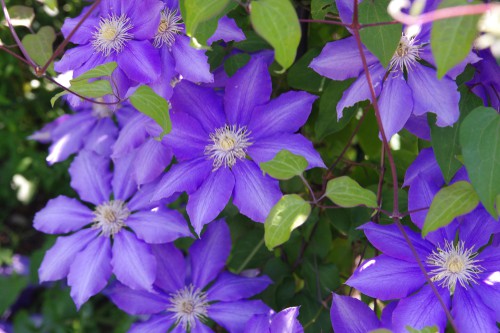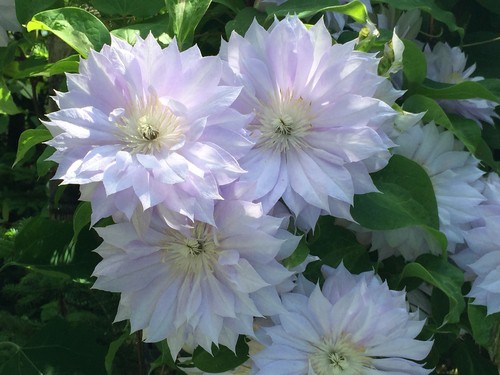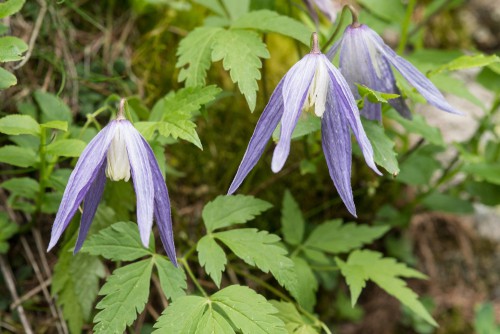Last updated on April 4th, 2022
Our site is reader supported, this means we may earn a small commission from Amazon and other affiliates when you buy through links on our site.
Clematis produce some of the most wonderful blooms and can truly add a magical quality to your garden. The trouble is, after putting in lots of hard work to give your clematis the perfect home, you might notice that things are not going as planned.
If you are having trouble with clematis wilt, there are things you can do to treat it and to prevent it from coming back again.
What is clematis wilt?
First of all, what is it, exactly? It is a form of fungus brought about by Calophoma clematidina and your clematis is not alone in their suffering either. This fungus actually affects all manner of large-flowered hybrids and even some small species.
Wilting is a serious problem for clematis, and wilting alone is not necessarily indicative of Calophoma clematidina. Wilting can be a problem you plant experiences even if it doesn’t have fungal problems. The key is to remember that:
- Large-flowered hybrids are more likely to be affected by Calophoma clematidina
- Resistant hybrids or species of Clematis are not likely affected by Calophoma clematidina, and instead are likely suffering from environmental problems.
So, while it is normal to immediately blame a fungus for wilting, unless it’s impacting a larger flowering hybrid that is known to be susceptible to fungus, it is probably physical damage, environmental issues or pests.
What does clematis wilt do?

Calophoma clematidina is able to live on dead or living plant matter, even in the soil. When the spores get transferred or splashed onto the clematis, they spread rapidly. Most of the time the root system is not killed and any young shoots that regenerate at ground level are fine. The infection is not fatal, however, if not treated, the plant will eventually die from secondary issues. It is for this reason that you must treat the issue early.
Clematis
In their natural environment clematis like deep and fertile soil, in a shaded area. Sometimes, however, they are planted in shallow soil, near homes or other buildings, in which case they can suffer from root stress. If you are growing the clematis as you ought to, check for environmental factors first, then consider the symptoms of Calophoma clematidina.
Symptoms to look out for
The symptoms of environmental factors and clematis wilt are quite similar, so pay particular attention to the following:
- When you have a fungal infection, it will rapidly affect the leaves and these will start to wilt. The stalks will turn black. The infection in the leaves manifests in subsequent wilting of the stems too.
- The fungal infection will show black colouring on stem tissue, which often splits open.
- Younger, healthier shoots that come from the base can also show the same symptoms.
Treatment for clematis wilt
If you have confirmed that your plants have clematis wilt, there are no chemical controls available, only non-chemical prevention methods.
For non-chemical control measures, you want to start by making sure the soil is deep enough, with mulch around the base of the plant to help prevent root stress. Clematis plants have a deep root system so always make sure you have nice deep soil and if growing them in containers use deep pots. We also recommend planting clematis a few inches deeper than they were in their original pot so some of the stems are planted below soil level. This will help prevent clematis root.
If you suspect a fungal infection, then cut away any wilted stems to the non-discoloured, healthy tissue and remove the affected material. Destroy it, do not add it to a compost pile because this can contaminate the soil.
Learn what you can add to your compost bin in this guide here.
Any tools you used for the process should be disinfected to avoid any accidental spread of the fungus to other plants. Tools can be cleaned using bleach or Jeyes Fluid.
Susceptible cultivars of clematis

There are some cultivars that are particularly susceptible. If you are growing any cultivars from the list below, exercise caution and non-chemical control measures early on:
- Clematis ‘Henryi’
- Clematis ‘Vyvyan Pennell’
- Clematis ‘Mrs N. Thompson’
- Clematis ‘Duchess of Edinburgh’
- Clematis ‘William Kennett’,
- Clematis ‘Marie Boisselot/Madame le Coultre’
- Clematis ‘Ernest Markham’
- Clematis ‘Comtesse de Bouchaud’
- Clematis ‘Jackmanii’
- Clematis ‘Nelly Moser’
There are also some that are resistant, and if they are wilting they are likely suffering from environmental issues. These include:
- Clematis ‘Avant Garde’
- Clematis ‘Bonanza’,
- Clematis ‘Confetti’
- Clematis ‘alpina’
- Clematis ‘montana’
- Clematis ‘orientalis’
- Clematis ‘integrifolia’
- Clematis ‘macropetala’
- Clematis ‘tangutica’

Again, this problem can spread quickly, especially if you are not careful to remove affected material. So, once you confirm the existence of clematis wilt, use all available measures to remove it. If you are planting new clematis, make sure you use all available resources to give it a good and proper home, one that helps keep it healthy so fungal infections are less likely to manifest and remember to plant them slightly deeper than they are in their original pots.
Image credits – Shutterstock.com


